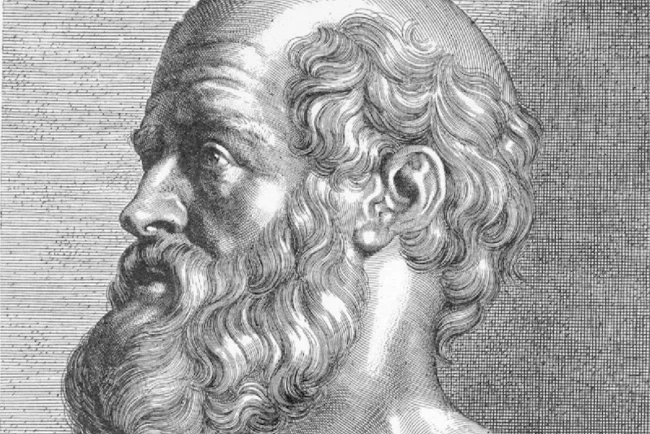The ancient Greek physician Hippocrates became the first scientist who, casting aside superstitions and mysticism, placed medicine on a scientific foundation. He is justly called the “father of medicine.”
The island of Kos in the Aegean Sea had been renowned for its physicians since ancient times. Even on the modern coat of arms of the capital of this island, the city of Kos, there is depicted the staff of the ancient Greek god of medicine Asclepius, entwined with a serpent. The art of healing was carefully passed down from generation to generation, and here arose glorious dynasties of physicians, one of which gave the world the “father of medicine” – Hippocrates.
Early life and training
It is known that Hippocrates was born in 460 BC. His ancestors, according to legend, had practiced medicine for eighteen generations. Hippocrates’ mother was a midwife, and his father was a physician. From childhood, his father began teaching Hippocrates the art of healing, and by the age of twenty he had already earned fame as an excellent physician. In those times, by tradition, physicians were obligatorily consecrated as priests of Asclepius, the god of medicine. The twenty-year-old Hippocrates also underwent this consecration.
Wishing to expand and supplement his medical knowledge, Hippocrates traveled to Egypt and lived there for several years. He familiarized himself with the state of medicine in many countries: in Asia Minor, Libya, even among the Scythians. Later he said that in order to fully master the art (of healing), one lifetime is not enough (this is the meaning of his saying “life is short, art is eternal”).
Returning to his native island, Hippocrates founded his medical school there.
Medical revolution – from mysticism to science
What views dominated medicine at that time? It was believed that diseases were caused by supernatural reasons. Therefore, the methods of treatment should be likewise supernatural. Physicians widely used spells, incantations, and prayers for treatment. Patients were often simply brought to make a sacrifice in the temple of Asclepius, and then they would recount to the priest-physicians the dream they had seen the following night. Medicine was prescribed based on the interpretation of the dream.
Hippocrates became a true reformer of ancient medicine. He was the first to approach it as a science. Diseases, he believed, have natural causes. These can be discovered by studying the structure and vital functions of the human organism. Hippocrates fought against abstract reasoning in medicine, calling it “medical painting.” He tried to bring his science “down from the heavens to earth.”
Holistic approach to medicine
Hippocrates taught that a physician should treat not the disease, but the patient. One must accurately establish the patient’s pulse rate, body temperature, sleeping position, and so on. The patient’s way of life, climate, drinking water, air, even the laws of the country where the person lives – everything can affect his health. Thus Hippocrates wrote in his work “On Airs, Waters, and Places.” Therefore, the ancient Greek physician is also considered the founder of medical geography.
A physician should be able to determine a patient’s condition by his external appearance alone. Hippocrates described, for example, the appearance of patients with severe diseases of the abdominal cavity: sunken eyes and cheeks, a sharpened nose, lips stuck together, an earthy complexion covered with drops of cold sweat. To this day, such a description is called the “Hippocratic mask.”
The theory of four humors and temperaments
Nevertheless, Hippocrates, as a man of his era and a philosopher by nature, could not completely abandon philosophical pursuits in his science, from that “medical painting” against which he himself objected.

An example of this is his teaching about the juices of the organism and types of bodily constitution. In the organism, according to Hippocrates, there are four liquid juices: blood, yellow bile, black bile, and phlegm. The fundamental aspect of a person’s bodily constitution type, as Hippocrates believed, is which juice predominates in the organism.
There are four such constitutional types in total. If phlegm (“phlegma” in Greek) predominates in a person’s organism, he was called a phlegmatic. This person is imperturbable, slow, calm, almost never showing his feelings.
If black bile (“melaina chole”) predominates in the organism, then such a person is a melancholic. He also sparingly displays his feelings, but is impressionable, withdrawn in his experiences, and often feels depression and sadness.
When blood (“sanguis”) predominates among the organism’s juices, then we speak of a sanguine – a person who is sociable, easily changes mood, with expressive facial expressions and gestures.
Finally, if the predominating juice in the organism is yellow bile (“chole”), then before us is a choleric – an unbalanced person, often unrestrained and quick-tempered, who violently expresses his feelings.
Even today we say that there are four basic types of human temperament – phlegmatic, melancholic, sanguine, choleric. Temperament in Latin means “proper proportion” (in this case – of the organism’s juices). Although from a modern point of view, the explanation of human temperament peculiarities by the proportion of juices in the body appears quite naive.
Medical expertise and achievements
In his works, Hippocrates deeply and thoroughly examined the most diverse areas of medicine. Proper nutrition is the subject of Hippocrates’ work “Diet in Acute Diseases.” He was an excellent surgeon and had a good understanding of anatomy. He knew and used more than two hundred medicinal plants for treatment.
Hippocrates studied epidemics, often traveled to places of mass disease outbreaks and treated patients. Thus, he spent several years in Athens during a severe epidemic (apparently, this was a plague epidemic). He summarized his experience in this field in the work “Epidemics.”
Hippocrates also acted as a psychiatrist. One such case is known. The inhabitants of the city of Abdera approached him with a request to examine a citizen of their city, Democritus. They were amazed by his extraordinary abilities, which they often perceived as oddities. This was the same philosopher Democritus who first came to the conclusion that everything in the world consists of indivisible particles – atoms. After careful examination, Hippocrates convinced the inhabitants of Abdera of the “normality” of their greatest fellow citizen Democritus. From this moment, apparently, began the long acquaintance of two great people of their time.
Medical ethics and legacy
In Hippocrates’ works, we find vivid sayings about patients, disease, and the art of treating them; some of these have become famous quotes (for example, his famous words that “life is short, art is eternal,” already mentioned by us).
Hippocrates formulated the moral code of a physician, the ethical norms of his behavior. The first commandment of a physician, according to Hippocrates, states: “Do no harm!”
From ancient times to the present day, every physician solemnly takes a medical oath in which he promises to keep medical secrets and under any circumstances not to leave a patient without medical help. This oath is attributed to Hippocrates and is called the “Hippocratic Oath.”
Historians have still not established the year of Hippocrates’ death. According to some data, he died at the age of 63, according to others – he lived 84 years.
Legend says that near Hippocrates’ grave, wild bees settled. The honey they produced possessed rare healing properties. Thus even after death, the great physician continued to heal people.
Sources
Encyclopedia for children, 1993, License nr. 062284.

Leave a Reply